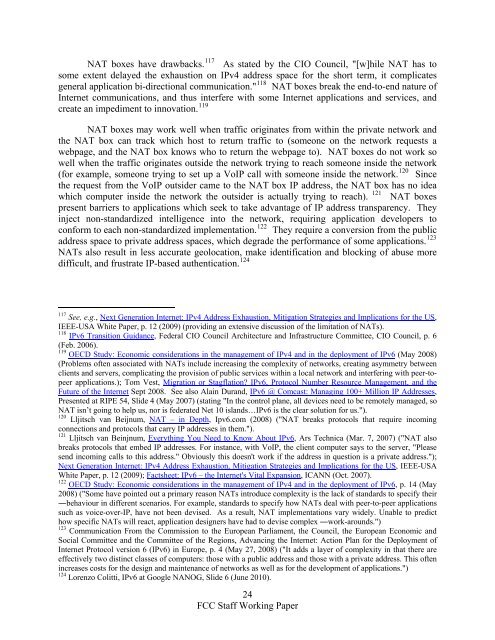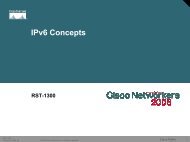IPv4 Exhaustion, IPv6 Transition, - Saudi Arabia IPv6 Task Force
IPv4 Exhaustion, IPv6 Transition, - Saudi Arabia IPv6 Task Force
IPv4 Exhaustion, IPv6 Transition, - Saudi Arabia IPv6 Task Force
Create successful ePaper yourself
Turn your PDF publications into a flip-book with our unique Google optimized e-Paper software.
NAT boxes have drawbacks. 117 As stated by the CIO Council, "[w]hile NAT has tosome extent delayed the exhaustion on <strong>IPv4</strong> address space for the short term, it complicatesgeneral application bi-directional communication." 118 NAT boxes break the end-to-end nature ofInternet communications, and thus interfere with some Internet applications and services, andcreate an impediment to innovation. 119NAT boxes may work well when traffic originates from within the private network andthe NAT box can track which host to return traffic to (someone on the network requests awebpage, and the NAT box knows who to return the webpage to). NAT boxes do not work sowell when the traffic originates outside the network trying to reach someone inside the network(for example, someone trying to set up a VoIP call with someone inside the network. 120 Sincethe request from the VoIP outsider came to the NAT box IP address, the NAT box has no ideawhich computer inside the network the outsider is actually trying to reach). 121 NAT boxespresent barriers to applications which seek to take advantage of IP address transparency. Theyinject non-standardized intelligence into the network, requiring application developers toconform to each non-standardized implementation. 122 They require a conversion from the publicaddress space to private address spaces, which degrade the performance of some applications. 123NATs also result in less accurate geolocation, make identification and blocking of abuse moredifficult, and frustrate IP-based authentication. 124117 See, e.g., Next Generation Internet: <strong>IPv4</strong> Address <strong>Exhaustion</strong>, Mitigation Strategies and Implications for the US,IEEE-USA White Paper, p. 12 (2009) (providing an extensive discussion of the limitation of NATs).118 <strong>IPv6</strong> <strong>Transition</strong> Guidance, Federal CIO Council Architecture and Infrastructure Committee, CIO Council, p. 6(Feb. 2006).119 OECD Study: Economic considerations in the management of <strong>IPv4</strong> and in the deployment of <strong>IPv6</strong> (May 2008)(Problems often associated with NATs include increasing the complexity of networks, creating asymmetry betweenclients and servers, complicating the provision of public services within a local network and interfering with peer-topeerapplications.); Tom Vest, Migration or Stagflation? <strong>IPv6</strong>, Protocol Number Resource Management, and theFuture of the Internet Sept 2008. See also Alain Durand, <strong>IPv6</strong> @ Comcast: Managing 100+ Million IP Addresses,Presented at RIPE 54, Slide 4 (May 2007) (stating "In the control plane, all devices need to be remotely managed, soNAT isn’t going to help us, nor is federated Net 10 islands…<strong>IPv6</strong> is the clear solution for us.").120 Lljitsch van Beijnum, NAT – in Depth, Ipv6.com (2008) ("NAT breaks protocols that require incomingconnections and protocols that carry IP addresses in them.").121 Lljitsch van Beinjnum, Everything You Need to Know About <strong>IPv6</strong>, Ars Technica (Mar. 7, 2007) ("NAT alsobreaks protocols that embed IP addresses. For instance, with VoIP, the client computer says to the server, "Pleasesend incoming calls to this address." Obviously this doesn't work if the address in question is a private address.");Next Generation Internet: <strong>IPv4</strong> Address <strong>Exhaustion</strong>, Mitigation Strategies and Implications for the US, IEEE-USAWhite Paper, p. 12 (2009); Factsheet: <strong>IPv6</strong> – the Internet's Vital Expansion, ICANN (Oct. 2007).122 OECD Study: Economic considerations in the management of <strong>IPv4</strong> and in the deployment of <strong>IPv6</strong>, p. 14 (May2008) ("Some have pointed out a primary reason NATs introduce complexity is the lack of standards to specify their―behaviour in different scenarios. For example, standards to specify how NATs deal with peer-to-peer applicationssuch as voice-over-IP, have not been devised. As a result, NAT implementations vary widely. Unable to predicthow specific NATs will react, application designers have had to devise complex ―work-arounds.")123 Communication From the Commission to the European Parliament, the Council, the European Economic andSocial Committee and the Committee of the Regions, Advancing the Internet: Action Plan for the Deployment ofInternet Protocol version 6 (<strong>IPv6</strong>) in Europe, p. 4 (May 27, 2008) ("It adds a layer of complexity in that there areeffectively two distinct classes of computers: those with a public address and those with a private address. This oftenincreases costs for the design and maintenance of networks as well as for the development of applications.")124 Lorenzo Colitti, <strong>IPv6</strong> at Google NANOG, Slide 6 (June 2010).24FCC Staff Working Paper
















